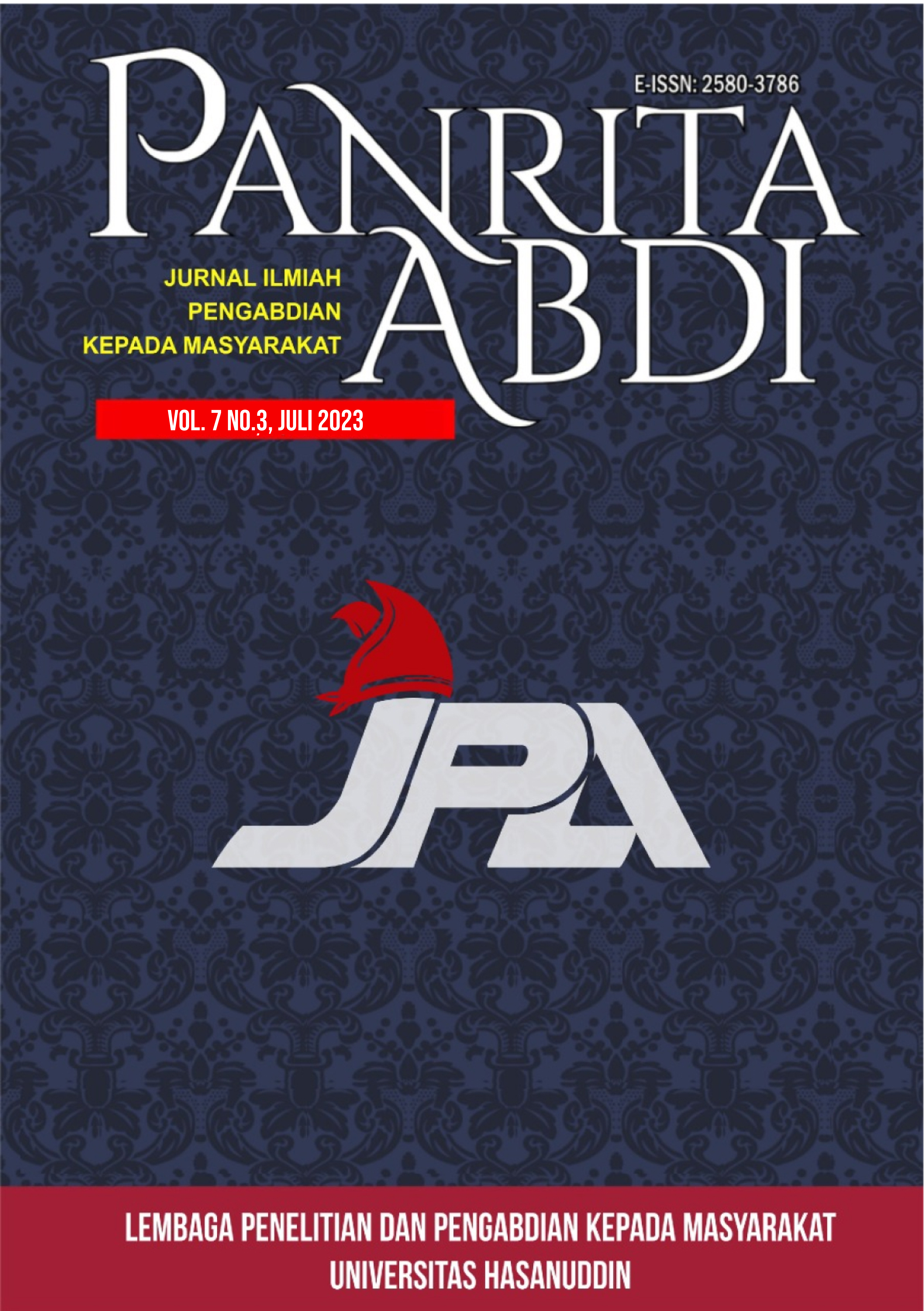PEMANFAATAN SERBUK DAUN BELIMBING WULUH (AVERRHOA BILIMBI LINN.) SEBAGAI PENOLAK LALAT DI PERUMAHAN TAMPAN PERMAI PANAM PEKANBARU
DOI:
https://doi.org/10.20956/pa.v7i3.21385Keywords:
Utilization, wuluh starfruit powder, flies repellentAbstract
One way to repellent flies is to use bioactive compounds found in plants, including starfruit leaf powder (Averrhoa bilimbi Linn.). This activity provides education about fly vectors and training on making starfruit leaf powder and its application in the trash. This activity aims to increase knowledge and develop the potential of starfruit leaf powder as a fly repellent in Tampan Permai Panam Housing Pekanbaru. The implementation method was lecture, question and answer, observation, demonstration of processing, and its application as a natural repellent against flies in the trash, which 20 participants attended. The result of implementing this service activity is an increase in participants' knowledge by as much as 76%, as seen from the post-test. In addition, there was an increase in participants' understanding of the steps of processing starfruit leaves into powder, which was seen by several participants who could explain and demonstrate the steps and processing methods again. Starfruit leaf powder given to the waste has been proven to repel flies, so that it can be used as a natural fly control. The results of this activity are expected to be input for the community to reject the fly population in the trash. --- Salah satu cara untuk mengusir lalat adalah dengan memanfaatkan senyawa bioaktif yang terdapat pada tanaman salah satunya serbuk daun belimbing wuluh (Averrhoa bilimbi Linn.). Kegiatan ini memberikan edukasi mengenai vektor lalat dan pelatihan proses pembuatan serbuk daun belimbing wuluh serta penerapannya di tempat sampah. Tujuan dari kegiatan ini adalah untuk meningkatkan pengetahuan dan mengembangkan potensi dari serbuk daun belimbing wuluh sebagai penolak lalat di Perumahan Tampan Permai Panam Pekanbaru. Metoda pelaksanaan dengan ceramah, tanya jawab, observasi, demonstrasi pengolahan dan penerapannya sebagai penolak alami terhadap lalat di tempat sampah yang dihadiri 20 peserta. Hasil dari pelaksanaan kegiatan pengabdian ini adalah adanya peningkatan pengetahuan peserta sebanyak 76% yang dilihat dari hasil pos-test. Disamping itu adanya peningkatan pemahaman peserta tentang langkah pengolahan daun belimbing wuluh menjadi serbuk, yang dilihat dari beberapa peserta dapat menjelaskan dan mendemontrasikan kembali mengenai langkah-langkah dan metoda pengolahan tersebut. Serbuk daun belimbing wuluh yang diberikan pada sampah terbukti dapat menolak lalat sehingga dapat dimanfaatkan sebagai salah satu pengendalian lalat secara alami. Hasil kegiatan ini diharapkan dapat sebagai masukan bagi masyarakat sebagai usaha untuk menolak populasi lalat di tempat sampah.
References
Ahmed, Q. U. (2018). Antiradical and Xanthine oxidase inhibitory activity evaluations of Averrhoa bilimbi L. Leaves and tentative identification of bioactive constituents through LC-QTOF-MS/MS and molecular docking approach. Antioxidants. MDPI AG, 7(10), pp. 1–16. doi: 10.3390/antiox7100137.
Alhassan, A. & Ahmed, Q. (2016). Averrhoa bilimbi Linn.: A review of its ethnomedicinal uses, phytochemistry, and pharmacology. Journal of Pharmacy and Bioallied Sciences. Medknow Publications, 8(4), pp. 265–271. doi: 10.4103/0975-7406.199342.
Baana, K., Angwech, H., & Malinga, G. M. (2018). Ethnobotanical survey of plants used as repellents against housefly, Musca domestica L. (Diptera: Muscidae) in Budondo Subcounty, Jinja District, Uganda. Journal of Ethnobiology and Ethnomedicine. BioMed Central Ltd., 14(1), pp. 1–8. doi: 10.1186/s13002-018-0235-6.
Khamesipour, F. (2018). A systematic review of human pathogens carried by the housefly (Musca domestica L.). BMC Public Health. BioMed Central Ltd., 18(1), pp. 1–15. doi: 10.1186/s12889-018-5934-3.
Kumar, P. (2012). Insecticidal evaluation of essential oils of Citrus sinensis L. (Myrtales: Myrtaceae) against housefly, Musca domestica L. (Diptera: Muscidae). Parasitology Research. Parasitol Res, 110(5), pp. 1929–1936. doi: 10.1007/s00436-011-2719-3.
Mossa, A. T. H., Mohafrash, S. M. M., & Chandrasekaran, N. (2018). Safety of natural insecticides: Toxic effects on experimental animals. BioMed Research International. Hindawi Limited, 2018, pp. 1–18. doi: 10.1155/2018/4308054.
Puspitaningsih, W. E. & Mahyuni, L. P. (2021). Pelatihan Pembuatan Daun Bidara Menjadi Produk Lulur Tradisional Di Desa Kutuh Training In Making Bidara Leaves Into Traditional Scrub Products In Kutuh Village. Jurnal Panrita Abdi, 5(4), pp. 488–499. Available at: http://journal.unhas.ac.id/index.php/panritaabd.
Rohmah, E. A., Subekti, S. & Rudyanto, M. (2020). Larvicidal Activity and Histopathological Effect of Averrhoa bilimbi Fruit Extract on Aedes aegypti from Surabaya, Indonesia. Journal of Parasitology Research. Hindawi Limited, 2020, pp. 1–5. doi: 10.1155/2020/8866373.
Sina, I., Zaharah, & Sabri, M. S. M. (2016). Larvicidal activities of extract flower averrhoa bilimbi L. Towards important species mosquito, anopheles barbirostris (diptera: Culicidae). International Journal of Zoological Research. Asian Network for Scientific Information, 12(1-2), pp. 25–31. doi: 10.3923/ijzr.2016.25.31.
Sucipto. D (2011) Vektor Penyakit Tropis. Yogyakarta: Gosyen Publishing.
Suluvoy, J. K. & Berlin Grace, V. M. (2017). Phytochemical profile and free radical nitric oxide (NO) scavenging activity of Avertrhoa bilimbi L. frui extract. 3 Biotech. Springer Verlag, 7(1), pp. 1–11. doi: 10.1007/s13205-017-0678-9.
Wahyuni, D. (2021) Buku Ajar Dasar Biomedik Lanjutan, Deepublish. Yogyakarta. Available at: https://books.google.co.id/books?hl=en&lr=&id=VFk-EAAAQBAJ&oi=fnd&pg=PP1&dq=Buku+Ajar+Dasar+Biomedik+Lanjutan&ots=o20BQOFDMU&sig=JEx3FuKD_5hZCBvxRaMB3rpXC48&redir_esc=y#v=onepage&q=Buku Ajar Dasar Biomedik Lanjutan&f=false (Accessed: 23 March 2022).
Wahyuni, D., Sari, P., & Hanjani, D. (2019). White Onion (Allium sativum)Extract as a Vegetablein Blowfly (Calliophoridae) Control. Jurnal Kesehatan Masyarakat http://journal.unnes.ac.id/nju/index.php/kemas, 15(2), pp. 248–258. doi: https://doi.org/10.15294/kemas.v15i2.20578.
Wahyuni, D. & Sari, W. (2021). Belimbing Wuluh (Averrhoa bilimbi Linn.) Leaf Powder as the Natural Repellent Against Meat Fly (Genus sarcopaga). KEMAS: Jurnal Kesehatan Masyarakat, 17(2), pp. 159–168. doi: 10.15294/kemas.v17i2.25548.
Wahyuni, D. & Yulianto, B. (2018). Basil leaf (Ocimmum basillum form citratum) Extract Spray in Controling Aedes aegepty. Jurnal Kesehatan Masyarakat (KEMAS), 14(2), pp. 147–156. doi: 10.15294/kemas.v14i2.8000.
Wanaratana, S. (2013). Experimental Assessment of Houseflies as Vectors in Avian Influenza Subtype H5N1 Transmission in Chickens. Avian Diseases. American Association of Avian Pathologists, 57(2), pp. 266–272. doi: 10.1637/10347-090412-Reg.1.
Wanaratana, S., Panyim, S., & Pakpinyo, S. (2011). The potential of house flies to act as a vector of avian influenza subtype H5N1 under experimental conditions. Medical and Veterinary Entomology. Wiley-Blackwell, 25(1), pp. 58–63. doi: 10.1111/j.1365-2915.2010.00928.x.
Downloads
Published
How to Cite
Issue
Section
License
Copyright (c) 2023 Denai Wahyuni, Wulan Sari, Henny Maria Ulfa, Risa Amalia

This work is licensed under a Creative Commons Attribution-NonCommercial-NoDerivatives 4.0 International License.











